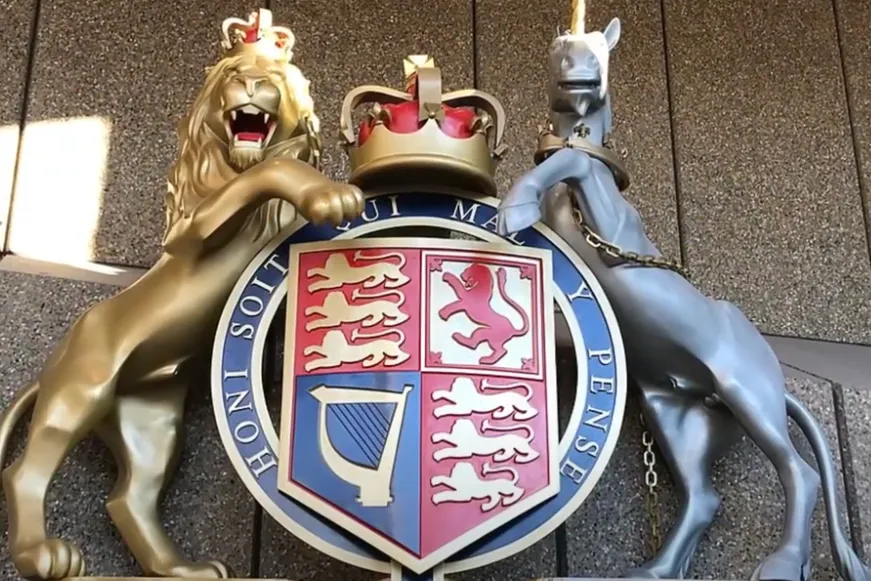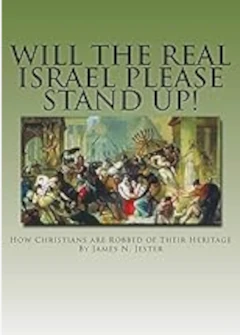Important History Not Being Taught Part 3
by Pastor Don Elmore
March 9, 2014
Scripture Reading: Acts 8:5-11
This is the story of two men with different views that are still in effect today, 2000 years later; two men with the same first name; Simon Peter and Simon Magus. It started in the capital city of Samaria, whose name was identical with its state; Samaria.
Simon Magus was a Babylonian priest. He was a part of the Babylonian community that had been living in the former land of Northern Israel. When the Israelites had been defeated and taken into captivity by the Assyrians, they were replaced by five tribes of the Babylonians. They eventually claimed fraudulently to be the true people of God while at the same time practicing many of their previous heathen rites which came directly from Babylon.
Simon Magus swayed the whole of the Samaritan nation that all gave heed to him for a very long time. But when Simon saw the potential of Christianity, he endeavored to buy an apostleship in the Church. But Peter knew what he was attempting to do and rebuked him sternly.
After his rejection, Simon Magus began to fashion his own “Christian” church. His plan was to design a church, of which he was the head, to overthrow the true Church of God. His idea was to adulterate Babylonian teachings with some of the teachings of Christ and thus create ONE LARGE FALSE UNIVERSAL CHURCH. It was to go against the SMALL TRUE ISRAELITE-ONLY CHURCH. The Israelite church allowed members from the House of Judah and the formerly divorced House of Israel—Adamic stock only.
Adolph von Harnack, the famous church historian, wrote an extensive seven-volume work titled The History of Dogma. He writes this about the area of Samaria where Simon got his start:
“Long before the appearance of Christianity, combinations of religion had taken place in Syria and Palestine, especially in Samaria, in so far as the Assyrian and Babylonian religious philosophy…with its manifold interpretations, had penetrated as far as the eastern shore of the Mediterranean” Volume 1, pp. 243, 244.
The people who lived in this area believed the Babylonian religion, for they were Babylonians. These Samaritans had amalgamated their Babylonian religious beliefs with some of the teachings from the Old Testament. But they never departed basically from their own Babylonian-Chaldean religious teachings.
This happened after living in the land of the former Northern Kingdom of Israel for a short time; they were plagued by a number of lions. They asked the King of Assyria to send them a former priest from the former occupants: the House of Israel. The priests of the House of Israel were not priests from the tribe of Levi, who God had ordained to be the tribe where only the priests could come. Jeroboam, the first king of the House of Israel, had forced the priestly Levites to flee back to Jerusalem and Judea when he did away with his people going to the temple in Jerusalem (2 Chronicles 11:14-15):
“For the Levites left their suburban lands; and their possession, and came to Judah and Jerusalem; for Jeroboam and his sons had cast them off from executing the priest’s office unto the LORD. And he appointed for himself priests for the high places, and for the he-goats, and for the calves which he had made.”
Jeroboam had instituted a religion that was devoid of God’s laws of worship. He set up calves in Dan and Bethel; he moved the feast days from the seventh to the eighth month; and he made priests of the lowest of the people, those who were not of Levi.
The false priest who the King of Assyria sent was a former priest of the House of Israel. He taught the Babylonians the false universal religion of the House of Israel. He taught the Samaritans (Babylonians) to believe what the former Northern Israelites had worshipped.
Notice what the Bible says in 2 Kings 17:41:
“So these nations [the five tribes of Babylonia: Samaritans] feared the Lord and served their graven images, both their children, and their children’s children: as did their fathers [the Babylonians], so do they unto this day.”
Simon Magus grew up in this religion. And when Christianity began Simon just appropriated Christ’s name, but continued the pagan abominations! He incorporated a few of the teachings of Jesus and mixed them up with the pagan practices, rituals and beliefs of the Babylonians. Simon used great demonic powers to do miracles and wonders. So, whereas, the Samaritans used to worship the adulterated Hebrew/Babylonian religion they now were worshipping the adulterated Christian/Babylonian religion.
The book of Acts tells us Simon became nominally a Christian. He physically and outwardly “entered” the Christian Church; by saying that he believed and he was baptized. Simon recognized that Christ’s power was greater than his but he wanted to be associated with that great name. Simon, seeing the potential of the Christian religion waited until the authorities, Peter and John, came to Samaria from Jerusalem and then offered to pay them money in order to obtain an apostleship in the Christian church. Peter rebuked Simon and told him that he couldn’t buy an apostleship. They actually didn’t accept his money? What! They turned down his money? Does this happen in today’s churches? Very, very seldom!
Simon Magus is called “the father of heresy.” In the old Christian Dictionaries and Encyclopedias and books on Christian and Church history, there is an unbelievable amount of literature devoted to him and his activities. In one of these; Hasting’s Dictionary of the Apostolic Church, Volume 2, and p. 496; it says:
“But it need not be supposed that when Simon broke with the Christians he renounced all he had learned. It is more probable that he carried some of the Christian ideas with him and that he wove these into a system of his own. This system did contain some of the later germs of Gnosticism. Thus he became a leader of a retrograde sect, perhaps nominally Christian and certainly using some of the Christian terminology but in reality anti-Christian and exalting Simon himself to the central position which Christianity was giving to Jesus Christ.”
What Simon did was to bring in the Babylonian religious beliefs into a form of Christianity in order to bring about a UNIVERSAL religion:
“The amalgam of pagans, and Christianity which was characteristic of Gnosticism, and which was especially obvious in the Simonian system, is readily explicable in the teaching of Simon Magus, who, according to the story in Acts, was brought into intimate contact with Christian teaching without becoming a genuine member.”
Simon only used the name of Christianity to bring about his own desired ends. The Dictionary of Religion and Ethics says that Simon was “A false Messiah, who practiced magical arts and subsequently attempted, by the aid and the sanction of Christianity, to set up a rival universal religion” Volume II, p. 514.
When Justin Martyr wrote in 152 AD in his Apology, he states that Simon Magus ...
“was a Samaritan, adding that his birthplace was a village called Gitta; he describes him as a formidable magician, and tells that he came to Rome in the days of Claudius Caesar (45 AD), and made such an impression by his magical powers, that he was honored as a god, a statue being erected to him on the Tiber, between the two bridges, bearing the inscription ‘Simoni den Sancto’ (i.e. the holy god Simon)”; Dictionary of Christian Biography, Volume 4, p. 682.
Samaria
Now let us look at Samaria in the days of Jesus Christ. As we have said before, very little of Jesus’ ministry occurred in this portion of the land of Israel. So let me ask you a question: In which of the three portions of ancient Israel; (1) Galilee, (2) Samaria or (3) Judea, would you have the largest following of a false minister, a deceiver that combined elements of Christianity and mixed them with paganism. Would it be in Galilee? Or would it be in Samaria? Or would it be in Judea?
When did it begin? Would it surprise you that the Bible indicates that it began right after Jesus Christ had ascended back to His father? The Babylonians were not considered to be a part of the covenant that God made with Israel. They were not a part of the Kingdom of Judah.
Who does the Bible identify as being the false teacher who led many away from true Christian-Israelite churches—it was no other than Simon Magus. The Bible gives practically the whole chapter eight in the Book of Acts, to tell about this very infamous Babylonian.
Acts, chapter 8, verse 9, tells us that “there was a certain man, called Simon, who previously in the same city used sorcery, and bewitched the people of Samaria, giving out that himself was some great one.” The rest of chapter 8 tells of what happened to this Simon.
When Simon Magus saw that Peter and John laid their hands on the believers and they received the Holy Spirit, he offered them money if they would tell him how to do this. Peter then rebuked Simon Magus and gave this evil, but very true prophesy against him in Acts 8:20-23:
“But Peter said unto him, Thy money perish with thee, because thou hast thought that the gift of God may be purchased with money. Thou hast neither part not lot in this matter; for thy heart is not right in the sight of God. Repent, therefore, of this thy wickedness, and pray God, if perhaps the thought of thine heart is not right in the sight of God. For I perceive that thou art in the gall of bitterness, and in the bond of iniquity.”
Simon Magus did not become a Christian. And did you notice that the Apostle of God didn’t accept his money? What! They turned down his money? Does this happen in today’s churches? Very, very seldom!
Simon was prophesied to being a gall of bitterness, which comes from the Old Testament scripture:
“(For ye know how we have dwelt in the land of Egypt, and how we came through the nations which ye passed by; And ye have seen their abominations, and their idols, wood and stone, silver and gold, which were among them); Lest there should be among you man, or woman, or family, or tribe, whose heart turneth away this day from the LORD our God, to go and serve the gods of these nations; lest there should be among you a root that beareth gall and wormwood.” Deuteronomy 29:16-18;
It was too hard for Simon Magus to keep the laws of God, for he loved the predominance and the magic that he was able to practice. He was the first major false preacher who taught the universal doctrine; “All races are equal; for they are all descended from the same person!” He eventually went to Rome in 45 AD under the reign of Claudius Caesar where a statue was made of him calling him “god.”
He mixed Babylonian with Christian principles to form his own universal religion. Does his religion sound familiar? The book of Acts was written by Luke in the year 62 AD. Acts does not tell of many of the activities of the disciples of the LORD, where they went and what they did; but it does tell of Simon Magus. Why? Because Luke knew that this powerful, false preacher would affect Christianity all the way to the end of the age.
Luke didn’t tell of some of the Apostles who started churches in the Alps, northern Africa, England, Greece, France, and elsewhere, but he did tell of Simon Magus. Simon Magus eventually went to Rome where he developed the mysterious religion that eventually sprang forth several centuries later under Emperor Constantine.
Luke was clearly showing that Simon was never a part of the Christian Church even though many of the people were being taught that Simon was a Christian and that he was appointed as an Apostle to bring the gospel to all the countries of the world (universal).
In “The History of Dogma” by Adolf von Harnack, it says:
“Long before the appearance of Christianity combinations of religions had been taken place in Syria and Palestine, especially in Samaria; in so far as the Assyrian and Babylonian religious philosophies.”
Simon Magus’ plan was to blend Babylonian and Christian philosophies into a universal counterfeit church:
“Proclaims a doctrine in which the Jewish [Hebrew] faith was strangely and grotesquely mixed with Babylonian myths, together with some Greek addition. This wild syncretism, or the melding of religions, was a universal religion which gained adherents for Simon.”
Simon Magus is called the “father of heresy.” He brought the Babylonian and Christian ideas and practices together: “The author, or first representative of this baptized heathenism, according to the uniform testimony of Christian antiquity, is Simon Magus, who unquestionably adulterated Christianity with pagan ideas and practices.”
The Catholics [Universalists] claim that Simon Peter, the Apostle of Jesus Christ, was the first Pope of the Catholic Church; but Simon Peter was never in Rome. The Bible says that he spent a lot of time in Babylon. But there was another who was a Babylonian, who lived in Samaria, who was an enemy of what Simon Peter believed. They were two leaders of movements that opposed each other: Simon Peter and Simon Magus. When one understands that “Peter” also means “interpreter”; then the understanding is that Simon Magus was also known as Simon Peter or Simon the Interpreter.
Here are six of the many Biblical reasons why Peter was not the Pope of Rome. Any one of these six would by themselves disprove the Roman Catholic Churches form of power:
Simon Peter’s commission was to become chief minister to the CIRCUMCISED, not to the uncircumcised Gentiles. The circumcised were the descendants of the House of Judah, while the uncircumcised Gentiles (nations) were the House of Israel of which Rome was a part of. They were the two kingdoms of ancient Israel.
Although, Peter was used to help start the conversion of the House of Israel, Peter was given the job of working with those of the House of Judah. This is very embarrassing to the Roman Catholics who teach the differently.
“But, on the contrary, when they saw that the gospel of the uncircumcision was committed unto me [Paul], as the gospel of the circumcision was unto Peter (For he that wrought effectually in Peter to the apostleship of the circumcision, the same was mighty in me toward the Gentiles)— And when James, Cephas [Peter], and John, who seemed to be pillars, perceived the grace that was given unto me, they gave to me and Barnabas the right hands of fellowship, that we should go unto the nations [House of Israel], and they unto the circumcision [House of Judah].” Galatians 2:7-9
The Apostle Paul is said in the Bible (2 Timothy 1:11) to be the “preacher, and an apostle, and a teacher of the Gentiles” [House of Israel]. Peter is nowhere mentioned as being the Apostle to the Gentiles. This would negate him from going to Rome to become the head of a Gentile community.
The teaching of Catholic historians tells us that Simon Peter went to Rome at the same time as Simon Magus in order to thwart his evils. This was during the reign of Claudius Caesar in 45 AD. After successfully combating the Magus, the historians continue with the story that Peter ruled as the Roman bishopric until 68 AD. Peter was then supposed to have been crucified upside down on Vatican hill and buried in a pagan cemetery.
It is just like the story of Sandy Hook. Do you believe the government’s story; that has changed over 50 times; or do you believe that is was a hoax? The Apostle Paul helped to establish the church at Rome. The Church was made up of many captured British royalty, and was not established until close to 60 AD.
The Roman Catholic historians would have us believe that Peter had established their church in 45 AD. But the truth is that neither Peter nor Paul established the Catholic Church. But it is utterly impossible for Peter to have been in any way associated with any Church at Rome. It is important for Christians to know that there was a huge difference between the Roman Catholics [founded by Simon Magus] and the Biblical Church at Rome [established by the Apostle Paul]. They were two different churches; one a large universal [catholic] church and the other a small inclusive church.
- When Paul spent two years in his own prison-house in Rome, he wrote the Epistles to the Ephesians, the Philippians, the Colossians, Philemon, and the Hebrews. And while Paul mentions others as being in Rome during that period, he nowhere mentions Peter. But according to Roman Catholic historians, Paul had been in Rome for over 20 years, but Paul does not mention Peter! He didn’t mention the Pope?
After Paul’s two years imprisonment was over, he was released. But about four years later (65 AD), he was returned to Rome to be a prisoner again. This time he had to appear before the throne of Caesar and was sentenced to death: “At my first defense no man stood with me, but all men [not as the universal’s say: but all the men in Rome] forsook me: I pray God that it may not be laid to their charge.” 2 Timothy 4:16
The Roman Catholics don’t read this verse in their churches; for it would mean that Peter forsook Paul. For they believe that Peter was very much present at Rome during this time of Paul’s trial.
- Where does the Bible say that Peter was? Here are a few of his Biblical highlights that tell of Peter’s location:
-
- About 35 AD Peter’s visit in Caesarea with Cornelius, the man who was a member of the former divorced House of Israel.
- In 45 AD Peter was cast into prison at Jerusalem (Acts 12:3, 4).
- In 49 AD Peter was still in Jerusalem, this time attending the Jerusalem council (Acts 15).
- About 51 AD Peter was in Antioch of Syria where he got into an argument with Paul because he wouldn’t sit or eat with the Gentiles. Very strange that the “Roman Pope” would have nothing to do with the Gentiles! (Galatians 2:11-14).
- About 66 AD Peter is in the city of Babylon among the House of Judah [the circumcised]! (1 Peter 5:13).
-
This is the Roman Catholic Church’s main belief: Since Jesus Christ ascended into Heaven, then the Pope is the successor of Jesus Christ on the earth today. If Simon Peter, the recipient of the “keys of the kingdom” was not in Rome, then the Pope as being the successor of Jesus Christ is false. He is not the Vicar of Christ! And the Roman Catholic Church is exposed as the big fraud that it is! But Jesus sent to His covenant people the Holy Spirit and said nothing about a human Vicar of Himself!
The New York Catechism says: “The Popes take the place of Jesus Christ on earth. By divine right, the Pope has supreme and full power in faith and morals over each and every pastor and his flock. He is the true Vicar of Christ, the Head of the entire Church, the father and teacher of all Christians. He is the infallible ruler, the founder of dogmas, the author of and the judge of councils, the universal ruler of truth, the arbiter of the world, the supreme judge of heaven and earth, the judge of all, being judged by no one, God Himself on earth.”
This is based on the fact that “The Catholic Church teaches that our Lord conferred on St. Peter the first place of honor and jurisdiction in the government of His whole Church and that the same spiritual supremacy has always resided in the Popes or Bishops of Rome as being the successors of St. Peter. Consequently, to be true followers of Christ all Christians, both among the clergy and laity, must be in communion with the See of Rome where Peter rules in the person of his successors;” “Faith of Our Fathers”, Cardinal Gibbons.
The Catholic Church claims Peter gave to it the keys of the gates of heaven and that no one will enter into God’s presence unless that Church opens the gates. The very word “Cardinal” means “hinge.” The Cardinals of the Roman Church are the hinges upon which the gate—the Pope—is able to turn.
But the words “Cardinal” and “Pope” are missing from the Bible. Where did the Roman Church get this mixture of religion in order to have Peter giving the keys to the Church? Rome became the home of all the gods of Asia. By Imperial times, Rome became the headquarters of pagan religion. It was the chief oracle of the world.
One of these gods in Rome was called Janus or Pater or Peter. Originally Janus was an ancient prince who reigned in the infancy of the world. He brought men from a rude and savage life to a mild and rational system. He was the first to build cities and the first to establish government over men. After his death, he was deified. This was Cain before and also Nimrod after Noah’s flood.
Janus is pictured as being double-faced. This was a symbol of his endeavor to change men from barbarism to civilization. One of Janus’ roles, after his deification as a god, was the continuation of his sacred task of “civilizing” men.
Janus was to the ancient Romans the “keeper of the gates of heaven and earth.” He is represented with a key in one hand as emblematic of his presiding over gates and highways. Janus’ face is double to denote his equal empire over the heavens and the earth. And that all things are open and shut to him at his will. That he governs the universe and alone possesses the power of making the world revolve on its axis; that he presides over the gates of heaven.
The Popes’ claim the same exact power today. He is said to be infallible and answers to no one for his actions, for he has the key given to him by Peter. In fact, Janus also controlled the calendar by his priests. The first month of the year was named after him to show his control over the years. So today, we still have JANU[S]ARY as the first month. The Catholic Church, like the priests of Janus, feels it has this same authority over the calendar today.
This mixture of paganism with Christianity goes on and on in the Roman Catholic Church. The Catholic Church had accepted the pagan festivals of Christ’s Mass (Saturnalia), Easter and a host of other rituals and beliefs. They claim to sit in Peter’s Chair and that the chief temple of the world is today called Saint Peter’s. The Church has accepted the practices and symbols of the oldest pagan religion on earth: Peter-worship—the religion of Cain and Nimrod with all of its symbols of obelisks and sun rays.
This was Satan’s attempt to smother God’s true religion with a counterfeit that to the untrained eye looks genuine. He did this principally through Simon Magus who amalgamated all the pagan religions in to this false UNIVERSAL religion and called the system “Christianity.”
This is the Roman Catholic Church’s main belief: Since Jesus Christ ascended into Heaven, then the Pope is the successor of Jesus Christ on the earth today. If Simon Peter, the recipient of the “keys of the kingdom” was not in Rome, then the Pope as being the successor of Jesus Christ is false. He is not the Vicar of Christ! And the Roman Catholic Church is exposed as the big fraud that it is! But Jesus sent to His covenant people the Holy Spirit and said nothing about a human Vicar of Himself!
There has always been the true churches of God and practically at the same time: the counterfeit Churches of God. The counterfeit arrangement is known as the political, economic and religious structure known as the beast system. It came into formal view during the reign of Emperor Constantine. It controlled most of Europe for over a thousand years. And then it suffered a death. The Roman Catholic Church died. When did that happen? It occurred in 1805, when Napoleon armies invaded Italy and kidnapped the Pope to France.
Jesuits
This all started when the Jesuits were born to counter the Protestant Revolution. The Protestant Revolution began around 1517. The Jesuit Order was founded under the invention of Ignatius Loyola, who was a witch and a member of the Alumbrados, was born in 1534. The main purpose of the Order was for the Pope to rule again as the sovereign leader.
The Council of Trent (1545-1563) ruled that anyone who doesn’t adhere to the teaching of the Catholic Church is worthy of death. The Jesuits began infiltrating missionaries and churches as well as gaining powerful positions as confessor to kings – they sought to use their confessions as blackmail to aristocracy, and this is how they gradually took power of leaders.
 The French, under King Louie XIV, kicked the Jesuits out; Portugal under Joseph III expelled them in 1759; Spain expelled them in 1767 under Charles III. The most powerful Catholic monarchs in the world expelled them and demanded that the Pope suppress them. So in 1773 Pope Clement XIV suppressed the Jesuits forever with a Papal bull, and so Maria Teresa, the Hapsburg Queen, expelled them from Austria. Over 83 countries, city-states, and cities expelled the power-hungry Jesuits. Only Russia, where orthodox Christianity existed, opposed the Vatican jurisdiction.
The French, under King Louie XIV, kicked the Jesuits out; Portugal under Joseph III expelled them in 1759; Spain expelled them in 1767 under Charles III. The most powerful Catholic monarchs in the world expelled them and demanded that the Pope suppress them. So in 1773 Pope Clement XIV suppressed the Jesuits forever with a Papal bull, and so Maria Teresa, the Hapsburg Queen, expelled them from Austria. Over 83 countries, city-states, and cities expelled the power-hungry Jesuits. Only Russia, where orthodox Christianity existed, opposed the Vatican jurisdiction.
In 1743, we have the beginning of the Rothschild (Bauer) banking interests. They learned that loaning money to governments and monarchy’s was much more profitable than loaning money to individuals or businesses. The head of the Illuminati is the Rothschild.
Several years before their expulsion, the Jesuits revived freemasonry. They wrote the different degrees of freemasonry and they were protected by Frederick the Great of Prussia. In 1776, Jesuits professor, Adam Weishaupt, organized the Illuminati in Bavaria. The Jesuits and masonry, including the illuminati, working together produced the French Revolution.
During the French Revolution, the Jesuits organized the killing of Louie XIV by the guillotine, for the revenge of the Jesuits being thrown out of France by the French monarch. The Jesuits then beheaded Marie Antoinette, the daughter of Maria Theresa; this was revenge for Maria Theresa for expelling the Jesuit Order from Austria.
They used Napoleon to drive out the people of the former King of France out of both Portugal and Spain. They drove the Knights of Malta off the island because they had expelled the Jesuits in 1768. And they marched into Italy and kidnapped the Pope. They imprison him for five years, humiliating him. This was revenge for the Pope for suppressing them forever.
The Pope, Pope Pius VII, was jailed at Avignon until he agreed, as the price for his release, to establish the Jesuit Order. This Jesuit war on the Vatican was terminated by the Congress of Vienna and by the secret, 1822 Treaty of Verona. Ever since, the Rothschilds have been the fiscal agents of the Vatican.
“It is my opinion that if the liberties of this country (USA) are destroyed, it will be by the subtlety of the Roman Catholic Jesuit priests, for they are the most crafty, dangerous enemies to civil and religious liberty. The have instigated most of the wars of Europe.” Marquis de LaFayette.
On February 9, 1929, Fascist Mussolini signed a Concordat (Lateran Pact) between he Italian Government and the Vatican – reestablishing the political power and diplomatic standing of the Catholic Church. Mussolini declares the Vatican an independent state.
The Catholic’s now have two Popes, one who is retired and the other is a Jesuit Pope. A Jesuit Pope? What does that mean?
When Jesus was alive, he came face-to-face with the Edom/Canaanite/Jew and the Samarian adulterated religion which has become the Catholic religion. The two enemies of our people were defeated by Jesus Christ and His ministry. They murdered Him, but He rose from the dead. That is why we will win the battle today.
Blessed be the LORD God of Israel.












